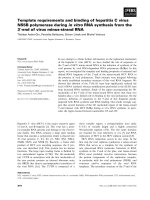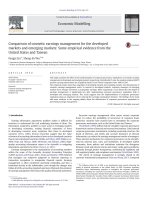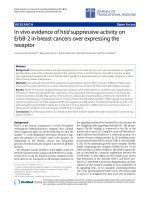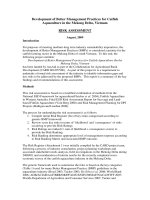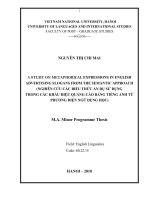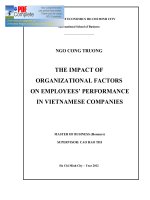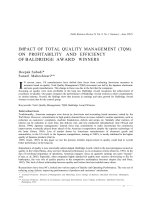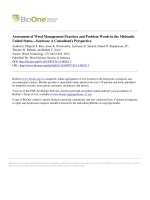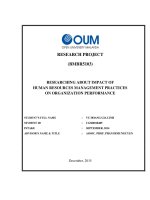Impacts of quality management practices on competitive performance in manufacturing companies experiences from the united states, japan, germany, italy, and korea
Bạn đang xem bản rút gọn của tài liệu. Xem và tải ngay bản đầy đủ của tài liệu tại đây (1.04 MB, 219 trang )
PHAN CHI ANH (PhD)
Impacts of Quality Management Practices
on Competitive Performance in Manufacturing
Companies - Experiences from the United States,
Japan, Germany, Italy, and Korea
VIETNAM UNIVERSITY PUBLISHER HOUSE, HA NOI
1
2
LIST OF CONTENTS
L I GI I THI U ............................................................................... 7
PREFACE ........................................................................................ 11
LIST OF TABLES ................................................................................... 17
LIST OF FIGURES ................................................................................. 20
Chapter 1. Introduction...................................................................... 21
1.1. Motivation and Objectives of This Research ......................... 21
1.2. Research Methodology ........................................................... 22
1.3. Structure of the Book .............................................................. 25
Chapter 2. Literature Review ........................................................ 27
Chapter 3. Design and Measurement Analysis ........................... 41
3.1. Research Framework............................................................... 41
3.2. Data Collection ........................................................................ 50
3.3. Measurement Analysis ............................................................ 56
Chapter 4. Quality Management Practices and Competitive
Performance: Empirical Evidence from Japanese Manufacturing
Plants ...................................................................................................... 66
4.1. Introduction ............................................................................ 66
4.2. Analytical Framework ............................................................. 68
4.3. Plant Characteristics ............................................................... 74
4.4. Hypotheses Testing ................................................................. 80
4.5. Implications and Discussions................................................. 91
4.6. Limitations and Further Research .......................................... 94
4.7. Conclusion ............................................................................... 94
3
Chapter 5.International Comparison on Quality Management
Practices in Manufacturing Companies: Empirical Evidences
from the United States, Japan, Germany, Italy, and Korea......... 96
5.1. Introduction ............................................................................ 96
5.2. Analytical Framework ............................................................. 98
5.3. Hypothesis Testing ................................................................ 106
5.4. Discussions and Implications............................................... 129
5.5. Limitations and Future Research ......................................... 131
5.6. Conclusions ........................................................................... 131
Chapter 6.Empirical Study on Effect of Quality Management
Practices and Just-In-Time Production Practices on Competitive
Performance in Manufacturing Companies ................................ 133
6.1. Introduction .......................................................................... 133
6.2. Background............................................................................ 135
6.3. Analytical Framework ........................................................... 138
6.4. Hypothesis Testing ................................................................ 144
6.5. Implications and Discussions............................................... 159
6.6. Limitations and Future Research ......................................... 163
6.7. Conclusions ........................................................................... 163
Chapter 7. The relationship between Quality Management
Practices and Their Effects on Competitive Performance ........ 165
7.1. Introduction ................................................................................ 165
7.2. Background............................................................................ 167
7.3. Analytical Framework ........................................................... 170
7.4. Hypotheses Testing ............................................................... 174
7.5. Discussions and Conclusions ............................................... 185
Chapter 8. Conclusions .................................................................... 189
8.1. Limitations of the Research .................................................. 189
8.2. Contributions to Academic Literature and Implications for
Practioners ............................................................................. 191
8.3. Future Research..................................................................... 193
4
REFERENCES ...................................................................................... 197
Appendix A: Question Items of Quality Management Scales Japanese Sample ........................................................ 204
Appendix B: Question Items of Quality Management Scales Five Countries Sample............................................... 210
Appendix C: Question Items of JIT Production Scales - Five Countries
Sample .......................................................................... 215
Appendix D: Question Items of Quality Performance and
Competitive Performance .......................................... 218
Appendix E: Contextual factors ....................................................... 219
5
6
L I GI I THI U
Ch=t l>?ng là mAt yBu tC quan trEng Fóng góp vào sH thành công
cJa viKc cLnh tranh toàn cMu cJa doanh nghiKp trên thO tr>Png quCc tB.
TQ quan FiRm chiBn l>?c cLnh tranh, ch=t l>?ng th>Png F>?c xem nh>
gCc rT cJa sH khác biKt. QuVn trO ch=t l>?ng bao gWm mAt loLt các hoLt
FAng F>?c thHc hiKn có hK thCng nhXm nâng cao ch=t l>?ng các quá
trình, FOnh h>[ng khách hàng, cVi tiBn ch=t l>?ng liên t\c, sH tham gia
cJa ng>Pi lao FAng, v.v… FR thiBt l^p và duy trì mAt l?i thB cLnh tranh.
Các nguyên t_c quVn trO ch=t l>?ng, qui trình và k` thu^t kiRm soát và
cVi tiBn ch=t l>?ng Fã F>?c áp d\ng và nghiên cbu rAng rãi trên thB gi[i
và F>?c thQa nh^n cho ncn tVng cJa quVn trO td chbc. Trong nheng
nfm gMn Fây quVn trO ch=t l>?ng Fã trg thành mAt trong nheng Fc tài
nghiên cbu quan trEng nh=t trong lhnh vHc quVn trO kinh doanh. Các
nhà khoa hEc cC g_ng phân tích mCi quan hK nhân quV giea ch=t l>?ng
và l?i thB cLnh tranh nhXm chj ra cho các nhà quVn trO th=y các >u tiên
và lA trình áp d\ng quVn trO ch=t l>?ng tLi doanh nghiKp.
CuCn sách chuyên khVo Tác ng c a qu n tr ch t l ng t i k t
qu c nh tranh c a các doanh nghi p s n xu t - Kinh nghi m t$ Hoa
K&, Nh)t B n, +,c, Ý và Hàn Qu1c trình bày các kBt quV nghiên cbu
thHc chbng vc hoLt FAng quVn trO ch=t l>?ng tLi 163 doanh nghiKp sVn
xu=t tLi 5 n>[c phát triRn trên thB gi[i là Hoa Kl, Nh^t BVn, mbc, Ý, Hàn
QuCc trong giai FoLn 2003-2008. HoLt FAng nghiên cbu này nXm trong
khuôn khd DH án nghiên cbu quCc tB High Performance Manufacturing
(HPM) do hqn 40 hEc giV quCc tB thHc hiKn liên t\c tLi 11 quCc gia tiên
tiBn trên thB gi[i tQ nfm 1988 FBn nay t^p trung vào các v=n Fc quVn trO
doanh nghiKp sVn xu=t trên các khía cLnh chiBn l>?c, nhân lHc, ch=t
l>?ng, churi cung bng, Fdi m[i sáng tLo…CuCn sách t^p trung trình
bày 4 nAi dung chính là:
Nghiên cbu mCi quan hK giea các c=u phMn cJa quVn trO ch=t
l>?ng, Ftc biKt là quan hK giea các hoLt FAng có tính ch=t ncn tVng
7
quVn trO ch=t l>?ng nh> quVn lý nguWn nhân lHc và chiBn l>?c v[i các
hoLt FAng k` thu^t và FOnh h>[ng vào kiRm soát và cVi tiBn quá trình.
Nghiên cbu tác FAng cJa thHc hành quVn trO ch=t l>?ng t[i mAt sC
kBt quV hoLt FAng cvng nh> l?i thB cLnh tranh tLi nhà máy chB tLo
nh> chi phí sVn xu=t, ch=t l>?ng sVn phwm, giao hàng Fúng hLn, tính
linh hoLt...
Nghiên cbu so sánh quVn trO ch=t l>?ng tLi các quCc gia khác nhau
nhXm làm rõ nheng sH t>qng FWng và khác biKt trong thHc hành quVn
trO ch=t l>?ng.
Nghiên cbu sH cAng h>gng lên kBt quV hoLt FAng khi tích h?p áp
d\ng quVn trO ch=t l>?ng v[i các hK thCng quVn trO sVn xu=t khác tLi các
nhà máy chB tLo.
KBt quV cJa nghiên cbu chj ra rXng viKc chú trEng áp d\ng các hoLt
FAng quVn trO ch=t l>?ng sz giúp các doanh nghiKp FWng thPi nâng cao
l?i thB cLnh tranh vc ch=t l>?ng sVn phwm và dOch v\, giVm chi phí sVn
xu=t, nâng cao tCc FA sVn xu=t cvng nh> tính linh hoLt cJa hK thCng
sVn xu=t.
BC c\c cJa cuCn sách bao gWm bVy ch>qng trong Fó ba ch>qng FMu
tiên trình bày tdng quát vc quVn trO ch=t l>?ng, các nghiên cbu ndi b^t
vc quVn trO ch=t l>?ng trên thB gi[i và khung khd phân tích quVn trO
ch=t l>?ng trong nghiên cbu này. Ch>qng 4 phân tích thHc trLng quVn
trO ch=t l>?ng tLi các nhà máy chB tLo Nh^t BVn, cái nôi cJa quVn trO
ch=t l>?ng hiKn FLi. Ch>qng 5 phân tích sH t>qng FWng và khác biKt vc
thHc hành quVn trO ch=t l>?ng tLi các n>[c phát triRn nh> Hoa Kl, Nh^t
BVn, mbc, Ý, Hàn QuCc. Ch>qng 6 phân tích mCi quan hK giea quVn trO
ch=t l>?ng và hK thCng sVn xu=t tinh gEn mà cCt lõi là ph>qng thbc sVn
xu=t JIT. Ch>qng 7 phân tích tác FAng giea các thHc hành ch=t l>?ng
khác t[i các kBt quV cLnh tranh cJa doanh nghiKp sVn xu=t. Các kBt
lu^n quan trEng cJa nghiên cbu cvng nh> hàm ý cho các nhà nghiên
cbu và thHc hành quVn trO ch=t l>?ng F>?c trình bày trong Ch>qng 8.
CuCn sách này có thR F>?c s{ d\ng trong các ch>qng trình Fào tLo
quVn trO kinh doanh g b^c FLi hEc và cao hEc nh> là sách chuyên khVo
cho các môn hEc quVn trO hEc, quVn trO ch=t l>?ng, quVn trO sVn xu=t và
8
tác nghiKp, Fdi m[i và sáng tLo, kinh doanh quCc tB. Các giVng viên,
nhà nghiên cbu, cán bA quVn lý doanh nghiKp có thR tham khVo tài liKu
này khi giVng dLy, nghiên cbu và thHc hành vc quVn trO ch=t l>?ng.
Tác giV cuCn sách xin bày t| sH cVm qn chân thành t[i các FWng
nghiKp thuAc DH án HPM và Trung tâm Nghiên cbu QuVn trO Kinh
doanh (CBAS), Tr>Png mLi hEc Kinh tB, mLi hEc QuCc gia Hà NAi, và
Ftc biKt là Giáo s> Matsui Yoshiki, Khoa QuVn trO Kinh doanh, mLi hEc
Tdng h?p QuCc gia Yokohama Fã h?p tác, h>[ng d~n, góp ý, và hr tr?
cho sH thành công cJa nghiên cbu này. Trong quá trình biên soLn cuCn
sách không thR tránh F>?c mAt sC khiBm khuyBt, tác giV xin trân trEng
Fón nh^n và tiBp thu các ý kiBn góp ý cJa FAc giV FR tiBp t\c có nheng
nghiên cbu chuyên sâu vc quVn trO ch=t l>?ng và quVn trO kinh doanh.
Tác gi6
9
10
PREFACE
Quality is a critical success factor for competition in global
markets. From the perspective of competitive strategy, quality is often
seen as a source of differentiation. Quality management consists of a
set of systematic activities to improve the quality level of products and
works through customer orientation, continuous quality improvement,
employees’ involvement, etc. so as to establish and sustain a
competitive advantage. Quality management principles, procedures,
and techniques have been widely accepted, applied, and studied. In
recent years, quality management became one of the most significant
research themes in operations management. The relationship among
quality management, quality performance, operational performance,
and financial performance has been widely investigated by many
scholars, who agreed that quality management practices have a
significant effect on quality and operational performances. Quality
management studies have utilized different analytical frameworks,
measurement constructs, and methodologies so far. Quality
management literature suggested that, however, the effect of quality
management practices on business performance is contingent on some
external factors such as the national culture, market environment, and
organizational context.
In order to heave better understanding on quality management,
this research investigates the relationship between quality
management practices, quality performance, and competitive
performance in the context of manufacturing plants. The objectives of
this research are to contribute to quality management by conducting
several studies in the following areas:
- To study the interrelationships among quality management
practices, particularly relations between human resource management/strategy-
11
oriented practices (infrastructure practices) and techniques/processoriented aspects (core quality practices) as suggested in the cited
literature of quality management.
- To investigate the direct and indirect effects of specific quality
management practices on different dimensions of competitive
performance.
- To study the international aspects of quality management for
better understanding the argument on “universality in applicability of
quality management.”
- To study the relationship among quality management and other
manufacturing management systems to know whether integrated
implementation of quality management practices and other improvement
practices yield a synergy effect on competitive performance of
manufacturing plants.
This research adopts the survey research method to accomplish
the objectives mentioned above. Data using in these studies had been
gathered from one hundred and sixty-three manufacturing plants in
five countries: the United States, Japan, Germany, Italy, and Korea in
the framework of High Performance Manufacturing (HPM) Project. This is
an ongoing international research project that focuses on studying the
“best practices” and their contributions to high performance.
This research underlines the approach “competing by best
practices” (Hayes and Wheelwright, 1984; Schroeder and Flynn, 2001).
The results of statistical analysis suggest that the ability to attain
competitive advantages can be built through the development of
consistent practices focused on designing, implementing, and
continuously improving processes to produce high quality products.
This research provides the new evidences of successful quality
implementation in Japanese plants where quality management is used
as a platform for achieving strength in other aspects of competitive
performance.
This research proposed and tested a framework of seven aspects of
quality management: top management support, information analysis,
12
strategic planning, workforce management, customer relationship,
supplier relationship, and process management. Interrelationships
among quality management practices were analyzed. It revealed the
significance of top management support and information analysis to
workforce
management,
customer
relationship,
and
supplier
relationship. In addition, successful process management highly
depended on the development and deployment of information analysis
and workforce management activities. The statistical analysis results
also indicated significant effects of process management, information
analysis, and workforce management on several performance
indicators regarding quality, cost, delivery, and flexibility.
The evidence of the synergy effect was found on the simultaneous
implementation of quality management practices and JIT production
practices, which supports the integration approach for improvement
(Schroeder and Flynn, 2001). The plants should select their own
improvement path by adopting quality management practices, JIT
practices, Total Preventive Maintenance (TPM) practices, etc. For the
manufacturing plant already started its improvement program with the
implementation of JIT production practices (or quality management
practices), additional implementation of quality management practices
(or JIT production practices) leads to the significant improvement of
manufacturing cost, volume flexibility, and cycle time.
The overall findings of this research may bring some implications
for quality practitioners and manufacturing managers who are looking
for solutions to improve manufacturing efficiency and effectiveness.
Beside of these, this research produces some significant contributions
to quality management studies as follows:
Firstly, this research proposed and tested a set of eleven constructs
measuring quality management practices. These constructs are all
present in the frameworks used for Malcolm Baldrige National Quality
Award in the United States and the European Quality Award. Statistical
testing reveals that those scales are reliable and valid for data of twenty-
13
seven Japanese plants and one hundred and sixty-three plants in five
countries. These measurement scales should be considered to use in
future quality management studies.
Secondly, this research tested and validated the Garvin’s concept
of eight dimensions of quality. This concept could be used for
measuring quality performance and the international comparison of
quality management in future research. In addition, the set of
cumulative capabilities suggested by Flynn and Schroeder (2001) has
been tested. These results provide the evidences that quality
performance and competitive performance should be treated as
multifaceted constructs in quality management studies.
Thirdly, this research provided a framework for the longitudinal
study on Japanese quality management. Continuing the work of Matsui
(2002), this research investigated industry-effect and time-effect on ten
specific quality management practices in Japanese plants. In addition,
effects of quality management practices on competitive performance
were compared for both periods of study.
Fourthly, this research provided an analytical framework for
international comparison of quality management. The similarities and
differences of quality management practices were identified not only
by evaluating the degree of implementation of specific quality
management practices but also by comparing their effects on different
dimensions of quality performance. Comparing the effects of quality
management practices, on quality performance allow the researchers
to identify the critical determinants for product quality.
This research found some statistical evidences related to the
argument on “universality in applicability of quality management”
mentioned in the cited literature. We found the evidence of significant
differences of quality management practices across the countries: the
United States, Japan, Germany, Italy, and Korea. In addition, evidence
of moderate effect of contextual factors on the implementation of
quality management practices and JIT production practices was
found. These findings may lead to the conclusion that effective
14
implementation of quality management practices should be contingent
upon
plant’s
environment
and
characteristics.
Successful
implementation of quality management depends on socio-economic
situation, technological evolvement, and national culture. The
manufacturing plants should select and implement the quality
management practices with respect to their customers and particular
situations.
The structure of this book is as follows: The first three sections
present the introductions, quality management literature, and
analytical framework of this study. Chapter 4 is entitled as “Quality
Management Practices and Competitive Performance: Empirical
Evidence from Japanese Manufacturing Plants.” Chapter 5 is entitled as
“International Comparison on Quality Management Practices in
Manufacturing Companies: Empirical Evidence from the United States,
Japan, Germany, Italy, and Korea.” Chapter 6 is entitled as “Empirical
Study on Effect of Quality Management Practices and Just-in-Time
Production Practices on Competitive Performance in Manufacturing
Companies.” Chapter 7 is entitled as “The relationship between Quality
Management Practices and Their Effects on Competitive Performance.”
Finally, Chapter 8 concludes this research by discussing its limitations,
contributions to quality management studies, implications for quality
practitioners, and suggesting directions for future research
This book would be used for business administration courses at
bachelor and master levels, especially useful for the following modules:
Management, Quality Management, Operations Management,
Innovation and Creative Management, and International Business. It
covers the essentials that lecturers, researchers, and business managers
need to know in teaching, researches, and practices about quality
management.
The author would like to express his sincere thanks to the
colleagues at the HPM Project and Research, Center of Business
Administration Studies (CBAS), Economics University, Hanoi National
University, and especially Professor Yoshiki Matsui, Faculty of Business
Administration, National University of Yokohama for their cooperation,
15
encouragement and suggestions during the research process. As
shortcomings are not unavoidable in compiling this book, the author
would like to welcome comments and opinions from the readers to
help us further study the issues of productivity and quality in Vietnam.
16
LIST OF TABLES
Table 2.1:
Table 2.2:
Table 3.1:
Table 3.2:
Table 3.3:
Table 3.4:
Table 3.5:
Table 3.6:
Table 3.7:
Table 4.1:
Table 4.2:
Table 4.3:
Table 4.4:
Table 4.5:
Table 4.6:
Summary of Major Instruments for Measuring the
Degree of the Use of Quality Management Practices ...... 29
Summaries of Studies on the relationship between
Quality Management and Organizational Performance .......35
Characteristic of Survey’s Respondents in “5 Countries
Sample” ............................................................................... 51
Survey Respondents ........................................................... 54
Measurement Analysis of Individual Scales for Japanese
Sample ................................................................................ 59
Measurement Analysis of Individual Scales
for Country-Wise Samples and Pooled Sample.............. 61
Correlation Analysis-Five Countries Sample ................... 63
Measurement Analyses of Super Scales — Five Countries
Sample ................................................................................ 63
Measurement Analysis of Quality Performance
and Competitive Performance ......................................... 65
Characteristic of Survey’s Respondents in Japanese
Sample ................................................................................ 76
Quality Practices in Japanese Plants between 1990’s
and 2000’s ........................................................................... 78
Testing for Industry- Effect on Quality Management
Practices in Japanese Plants ............................................. 83
Testing for Time- Effect on Quality Management
Practices in Japanese Plants ............................................. 83
Test for Industry- Effect and Time- Effect on Quality
Management Practices in Japanese Plants ..................... 84
Competitive Performance in Japanese Plants
in 1990’s and 2000’s ........................................................... 85
17
Table 4.7:
Table 4.8:
Table 5.1:
Table 5.2:
Table 5.3:
Table 5.4:
Table 5.5:
Table 5.6:
Table 5.7:
Table 5.8:
Table 5.9:
Table 5.10:
Table 5.11:
Table 5.12:
Table 6.1:
Table 6.2:
Table 6.3:
Table 6.4:
Table 6.5:
Table 6.6:
Table 6.7:
Table 6.8:
18
Correlation Analysis of Quality Management and
Competitive Performance in Japanese Plants ................ 86
Stepwise Regression Analysis on Relationship
between Quality Management and Competitive
Performance in Japanese Plants ....................................... 88
Quality Management Practices Classified by Countries .. 104
Post-hoc Tukey Test Values for Country Comparison .... 105
Correlation Analysis of Quality Practices and Quality
Performance ..................................................................... 109
Regression Analysis with Country Dummy Variables
(US, GER, ITA, KOR) ........................................................ 115
Regression Analysis of Product Performance (PERF) ..... 121
Regression Analysis of Product Features (FETR) ........... 122
Regression Analysis of Product Reliability (RELB) ....... 123
Regression Analysis of Conformance to Standards
(CFSD) .............................................................................. 124
Regression Analysis of Product Durability (DURB) ...... 125
Regression Analysis of Serviceability (SRVA) ................ 126
Regression Analysis of Aesthetics (AEST) ...................... 127
Regression Analysis of Perceived Quality (PCQT) ........ 128
Summary of Literatures of Quality Management
and JIT Production .......................................................... 137
Correlation Analysis .......................................................... 146
Quality Management Practices Classified by Groups ... 149
JIT Production Practices Classified by Groups .............. 149
Competitive Performance classified by High and Low
Implementation of Quality Management Practices ......... 150
Competitive Performance classified by High and
Low Implementation of JIT Production Practices ........ 150
Testing the Difference in Competitive Performance
between High and Low Implementation of Quality
Management Practices .................................................... 151
Testing the Difference in Competitive Performance
between Higher and Lower Implementation of JIT
Production Practices ....................................................... 152
Table 6.9:
Table 6.10:
Table 6.11:
Table 6.12:
Table 7.1:
Table 7.2:
Table 7.3:
Table 7.4:
Testing the Difference in Competitive Performance
between Higher and Lower Implementation of Both
Quality Management and JIT Production Practices ....... 153
Quality Management Practices and JIT Production
Practices Classified by Plant Size ................................... 155
Quality Management Practices and JIT Production
Practices Classified by Production Type ....................... 157
Effect of Contextual Factors on Implementation of
Quality Management Practices and JIT Production
Practices............................................................................ 158
Correlations and Descriptive Analysis ............................ 175
Summary of Path Analysis (Relationship among
Quality Management Practices) ..................................... 178
Summary of Path Analysis (Relationship between
Quality Management Practices and Competitive
Performance) ................................................................... 179
Decompositions of Path Coefficient and Model Fits ..... 180
19
LIST OF FIGURES
Figure 3.1:
Research Framework of Study on Effects of Quality
Figure 4.1:
Management, JIT production, Quality Performance
and Competitive Performance ......................................... 43
Framework of Study on Japanese Quality Management...... 70
Figure 5.1:
Framework of Comparative Study on Relationship of
Figure 6.1:
Quality Management and Competitive Performance ...... 99
Analytical Framework of Study Quality Management
Figure 7.1:
and .................................................................................... 140
Proposed Framework ...................................................... 172
Figure 7.2:
Summarization of Direct Effects among Variables....... 111
20
INTRODUCTION
1.1. Motivation and Objectives of This Research
Quality is a critical success factor for competition in global
markets. From the perspective of competitive strategy, quality is often
seen as a source of differentiation. Quality management consists of a
set of systematic activities to improve the quality level of products and
works through customer orientation, continuous quality improvement,
employees’ involvement, etc. so as to establish and sustain a
competitive advantage. Quality management principles, procedures,
and techniques have been widely accepted, applied, and studied. In
recent years quality management became one of the most significant
research themes in operations management. The relationship among
quality management, quality performance, operational performance,
and financial performance has been widely investigated by many
scholars, who agreed that quality management practices have a
significant effect on quality and operational performances. Some of
them suggested that, however, the effect of quality management
practices on business performance are contingent on some external
factors such as the national culture, market environment, and
organizational context (Rungtusanatham et al., 2005; Flynn and
Saladin, 2006, Zhao et al. 2006). Quality management studies have
utilized different analytical frameworks, measurement constructs, and
methodologies so far. A decade ago Filippini (1997) suggested that
“there were, and still are, many questions left unanswered, among
which are: the component of total quality and their measurements, the
impact of different practices on performance, condition under which
various interventions can be applied and their effects”. More recently,
Sousa and Voss (2002) conducted an intensive review the existing
quality management literature and suggested that three areas of quality
21
management need more studies. They include the linkages between
the several quality management practices, interactions between quality
management and other best practices, and relations between the
implementation of quality management practices and performance. In
order to meet this requirement, this research investigates the
relationship between quality management practices and competitive
performance in the context of manufacturing plants. The objectives of
this research are to contribute to quality management by conducting
several studies in the following areas:
- To study the interrelationships among quality management
practices,
particularly
relations
between
human
resource
management/strategy-oriented practices (infrastructure practices) and
techniques/process-oriented aspects (core quality practices) as
suggested in the cited literature of quality management.
- To investigate the direct and indirect effects of specific quality
management practices on different dimensions of competitive
performance.
- To study the international aspect of quality management for
better understanding the argument on “universality in applicability of
quality management.”
- To study the relationship among quality management and other
manufacturing management systems to know whether integrated
implementation of quality management practices and other
improvement practices yield a synergy effect on competitive
performance of manufacturing plants.
1.2. Research Methodology
The empirical research method is a useful approach to fill the gap
between operations management theory and practices (Flynn et al.,
1990). Since the 1980s, the operations management discipline has
witnessed increased deployment of empirical research particularly
survey research. These empirical studies provided rich contributions to
the literature of operations management. Many empirical studies on
22
quality management have been conducted since 1990s. The early stages
of empirical research in quality management created constructs for
measuring quality management practices and performance, which are
reflected in the evaluation criteria used for the national quality awards,
such as the Malcolm Baldridge National Quality Award in the United
States and the European Quality Award. Using these constructs, many
scholars have examined the relationship between quality management
practices and performance. This study would like to adopt the survey
research method to accomplish the objectives mentioned in the
previous subsection. A framework of using measurement constructs for
quality management practices and competitive performance in
manufacturing plants is introduced and tested later in Chapter 3.
This research is organized in four complementary sub-studies
which focus on investigating the relationship among quality
management practices, JIT production practices, quality performance,
and competitive performance from different perspectives.
The first sub-study focuses on Japanese quality management.
Japanese manufacturing organizations started their growth path by
implementing company-wide quality improvement activities since
1950s. The successful implementation of quality management was a
critical factor enabling Japanese manufacturing plants to achieve the
outstanding performance during 1970s-1980s, which was studied by
many scholars both inside and outside Japan. The first sub-study
continues this stream by investigating the implementation of quality
management practices and their effect on competitive performance
during 1990s-2000s when Japanese economy encountered several
crises. This study intends to answer the following research questions:
- Is there any difference and similarity in quality management
practices among different Japanese industries recently?
- Is there any difference and similarity in Japanese quality
management of manufacturing plants during 1990’s and 2000’s?
- Does the Japanese quality management still contribute to
competitive performance of the manufacturing plants?
23
Analysis of Variance (ANOVA) and regression techniques were used
to explore the questions. The findings of this study highlight the
robustness and stability of quality management practices and their
significant effects on competitive performance of Japanese
manufacturing plants.
The second sub-study focuses on the international aspect of
quality management. It aims to investigate “the universality in
applicability of quality management” by comparing the quality
management practices in manufacturing plants across the developed
countries such as the United States, Japan, Germany, Italy, and Korea.
This sub-study focuses to answer the following research questions:
- Is there any difference or similarity in the implementation of
quality management practices among countries?
- Is the effect of quality management practices on different
dimensions of quality performance similar across the countries?
Simple correlation analysis and regression analysis were conducted
for answering the questions, which indicated the significant impacts of
quality management practices on different dimensions of quality
performance. In addition, significant differences on determinants of
quality performance across the countries were detected.
The third sub-study focuses on investigating relations between two
improvement programs in manufacturing plants: quality management
and JIT production. The research question is “Does the simultaneous
implementation of quality management and JIT production yield a
synergy effect on competitive performance?” Correlation analysis and
Analysis of Variance (ANOVA) technique were used to answer the
question. The results indicate that the simultaneous implementation of
quality management and JIT production practices result in significantly
higher competitive performance than the implementation of practices
from either quality management or JIT production.
The fourth sub-study focuses on analyzing the direct and indirect
relations among quality management practices and effects of these
practices on different dimensions of competitive performance by
24
developing an empirical framework. This study intends to answer the
following research questions:
- How
practices?
are interrelationships among
quality
management
- How are the direct and indirect effects of specific quality
management practices on quality, cost, delivery, and flexibility?
Path analysis technique was used to test the proposed framework.
The results indicate the strong effect of top management support and
information analysis on other quality management practices such as
workforce management, customer relationship, and supplier
relationship. In addition, the significant effect of process management
on competitive performance was found.
This research is based on the database of the High Performance
Manufacturing (HPM) Project. This is an ongoing international
research project which focuses on studying the “best practices” and
their contributions to high performance. Several empirical studies on
quality management have been already conducted based on the HPM
database. In this research, the first sub-study was accomplished by
analyzing the data which had been gathered from two surveys
including the common sample of twenty-seven Japanese
manufacturing plants in 1993-1994 and 2003-2004. The second, third
and fourth sub-studies were accomplished by analyzing the data which
had been gathered from one hundred and sixty-three manufacturing
plants in five countries: the United States, Japan, Germany, Italy, and
Korea. Prior to addressing these questions, measurement scales had
been tested against reliability and validity.
1.3. Structure of the Book
The structure of this book is as follows. First, the intensive
literature review of empirical studies on the relationship between
quality management and competitive performance is summarized in
Chapter 2. It presents the development of the quality management
constructs and the utilizations of these constructs in empirical studies
25
